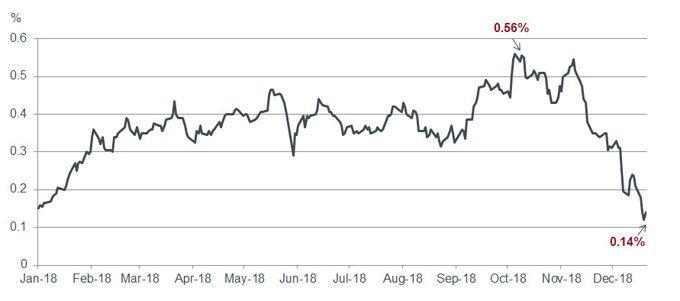
Janus Henderson: Parsing for nuance in the Fed’s statement
On Wednesday 19 December, the US Federal Reserve (Fed) raised interest rates. Ryan Myerberg, Portfolio Manager within the Global Bonds team, examines the outcome of the meeting and the reaction in the markets.
27.12.2018 | 13:00 Uhr
Rate hiked, but the evolution of the Fed’s thinking was the real focus
The US Federal Reserve (Fed) hiked its reference rate by 0.25% at its last meeting of the year, but as the market had almost fully priced this move, it was never going to be the main focus of the day’s events. Rather, it was the wait to hear the evolution of the Fed’s thinking on the current state of play in the US and the global economy, revisions to the Summary of Economic Projections (SEP) and in particular, the ‘dot plot’, which is the Federal Open Market Committee (FOMC) members’ estimates for the fed funds target rate in the coming years.
It was quite clear that the market went into the meeting expecting to hear a significantly more dovish outlook from the Fed. While there were some dovish shifts in the written statement and comments from Chairman Powell, in aggregate, the message from the Fed was more balanced than the market had anticipated. The median dot for next year was revised down to imply two hikes from the previous three, while the dots for 2020, 2021 and longer term, were also lowered by 25 basis points. Small revisions lower were made to the Fed’s GDP forecast, as well as a small shift higher in the expected unemployment rate.
There was also a small shift to the language regarding rate hikes in the FOMC statement — but not nearly as dovish as the market had hoped. The sentence in recent statements that referenced ‘further rate hikes’ was not removed as some in the market had anticipated but was modestly softened to suggest that “some” further hikes were likely.
Our read on the Fed statement
Parsing for the nuance in Fed statements has become a cottage industry for Fed watchers and this statement provides plenty of grist for the mill. Our read is that on balance the FOMC is certainly more concerned about the backdrop today than it was in previous months, but the committee still believes the US economy is on a firm footing and is clearly inclined to continue to move rates higher over time.
We have also felt this December meeting was always going to be a challenging balancing act for the Fed. The Fed has been on autopilot, hiking rates eight times over the past nine quarters while the US economy has been on a strong growth trajectory, and with unemployment grinding lower to levels not seen since the late 1960’s. It has also been on autopilot with the roll-off of the securities on its balance sheet, which the market has dubbed ‘quantitative tightening’ or QT.
While the Fed’s preferred measure of inflation, core personal consumption expenditure (PCE), has not necessarily risen to levels that would be more representative of a tight labour force when viewed on past precedent, it has taken a sanguine view on both the anchoring of inflation expectations at around the 2% target, and expectations that realised inflation would continue to be at target over its forecasting horizon.
However, it was not many months ago that the Fed appeared secure in its communication to the market that the current state of play in the economy would allow it to continue to normalise rates in a consistent fashion, which certainly fits with its desire to get the fed funds rate to a higher final resting point before the end of the economic cycle.
Slowing US economic momentum figures in the Fed’s thinking
It is clear, though, that recent data have shown some slowing of US economic momentum. Regional Fed surveys and Purchasing Manager Indices (PMIs) are no longer at their previous highs and concerns over an increase in trade tensions continue to weigh on the global economy. Perhaps a more evident sign of this slowdown to the market, to the man on the street, and especially President Trump, has been the sharp correction lower in US equity markets, with the Dow Jones and S&P 500 indices down 13% and 14.5% respectively from their 2018 highs. This move, coupled with a widening of credit spreads and other inputs to the Fed’s models, has tightened financial conditions in the US, which is a development that the Fed is watching very closely.
An understandable reaction
The bond market’s reaction to this has been one of understandable concern. Yields have moved meaningfully lower, the curve has flattened and the market is now pricing in less than one full hike from the Fed for the whole of 2019 (see chart).
Fed funds futures (market) pricing for Fed hikes in 2019 peaked in October

Source: Janus Henderson Investors, Bloomberg, as at 20 December 2019
It is our opinion, looking through a longer-term lens, that the US economy is healthier than the recent market price action would suggest. However, the heightened fears around a slowdown and impending recession — and the consequent impact on risky and risk-free assets — makes sense to us. Every incremental day from here extends the second longest period of expansion in US economic history; one that is nearly two times longer than the post-World War II average. Tighter financial conditions, global trade and growth worries, and fears of a Fed policy error caution us to bear in mind that all good things must come to an end.




Diesen Beitrag teilen: